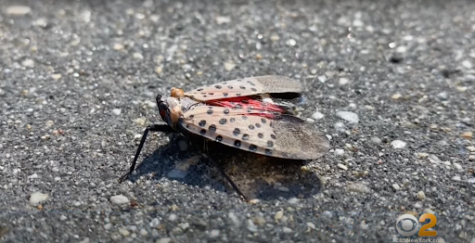
Spotted Lanternflies — also known as Lycorma delictua — are insect species native to parts of China. They were first detected on U.S. soil in 2014 Pennsylvania and since then, they have spread to several states including Connecticut, New York and North Carolina.
The Spotted Lanternfly life cycle begins when eggs are laid from September to December; the next stage occurs between May and June when the batch of eggs hatch. By July, the final stage consists of the full growth and maturity of the eggs, signaling for the bug’s life cycle to repeat.
What is an invasive species and why are Spotted Lanternflies considered invasive in the U.S.?
The National Ocean Service defines an invasive species as an organism that causes ecological or economic harm in a new environment it is not native to. Since the insects have limited natural predators and are causing grave damage across the U.S., they are an invasive species.
Spotted Lantern Flies are causing damage to trees in states where they can be found. Right now, the damage that lanterflies can do to U.S. ecosystems is unclear, but a study done by the Pennsylvania Department of Agriculture in 2019 showed that the damage done by SLFs could cost the state $324 million annually.
According to the U.S. Department of Agriculture (USDA), some plants at risk of being destroyed by SLF are maple, walnut and apple trees.
The flies are sap suckers, meaning they like to feed on ornamental fruits and woody trees. Once they feed on these fruits and trees they leave honeydew, a sugary-water waste product that makes the leaves shiny to encourage the growth of mold that can damage agriculture.
They also impact the quality of life of people in affected areas. Spotted Lanternflies like to swarm on trees and in the air, which makes it hard for people to enjoy the outdoors during the spring and summer.
“I was waiting for the bus and one was just chilling on a guy’s leg,” said Leilani Robinson, a freshman business student. “I was in Pennsylvania a few weeks ago and they were surrounding our hotel. You could tell it wasn’t because the hotel wasn’t clean, they just don’t have boundaries and spread everywhere.”
How can we help?
We should all be on high alert for any Spotted Lanternflies sightings. The New York State Government has outlined what New Yorkers should do when they see an SLF. If you see one in New York City, you do not need to report it. However, if you see one outside of the city you should report it to the New York Department of Agriculture. For more information on this, you can visit Spotted Lanternfly | Agriculture and Markets.
When you see SLF egg masses, you should destroy them. A SLF can lay up to 50 eggs during its mating season. To learn how to identify SLF egg masses, you can visit, What Should You Do With Spotted Lanternfly Egg Masses?
If you see one while you are going about your day, kill it on sight. Even though you may feel like killing one will not help our local ecosystems, SLF lays 30 to 50 eggs during mating season. Just think of it as preventing 30 to 50 possible Spotted Lanternflies from being born next year.








Jeannette Torres • Oct 26, 2022 at 10:01 pm
Dayanara, great article, and very informative. Thank you for sharing.
I’m looking forward to more of writing. Dd